Yesterday we examined Wine Lister founder, Ella Lister’s top left bank picks from the recent re-tasting of 204 Bordeaux 2016s, now in bottle.
Almost as many wines stood out across appellations on the right bank, from a tasting the following day of 171 wines – testament to the fantastic quality available across the board in 2016. There is no doubting 2016 is a great vintage in Bordeaux. Tasting these wines from bottle only served to confirm the Wine Lister team’s enthusiasm during en primeur tastings in the spring of 2017. Revisit our blog post from the time for details of the unusual weather conditions behind this vintage.
Wine Lister right bank highlights include 11 Saint-Emilion wines vs. 10 in Pomerol, and the top pick overall was Figeac, which was “intellectual”, “fine-boned” and “gourmand”.
Several of its well-known Saint-Emilion neighbours also made the cut into Wine Lister tasting highlights, including Canon ( “feather-light, but generous”), Clos Fourtet, and La Gaffelière.
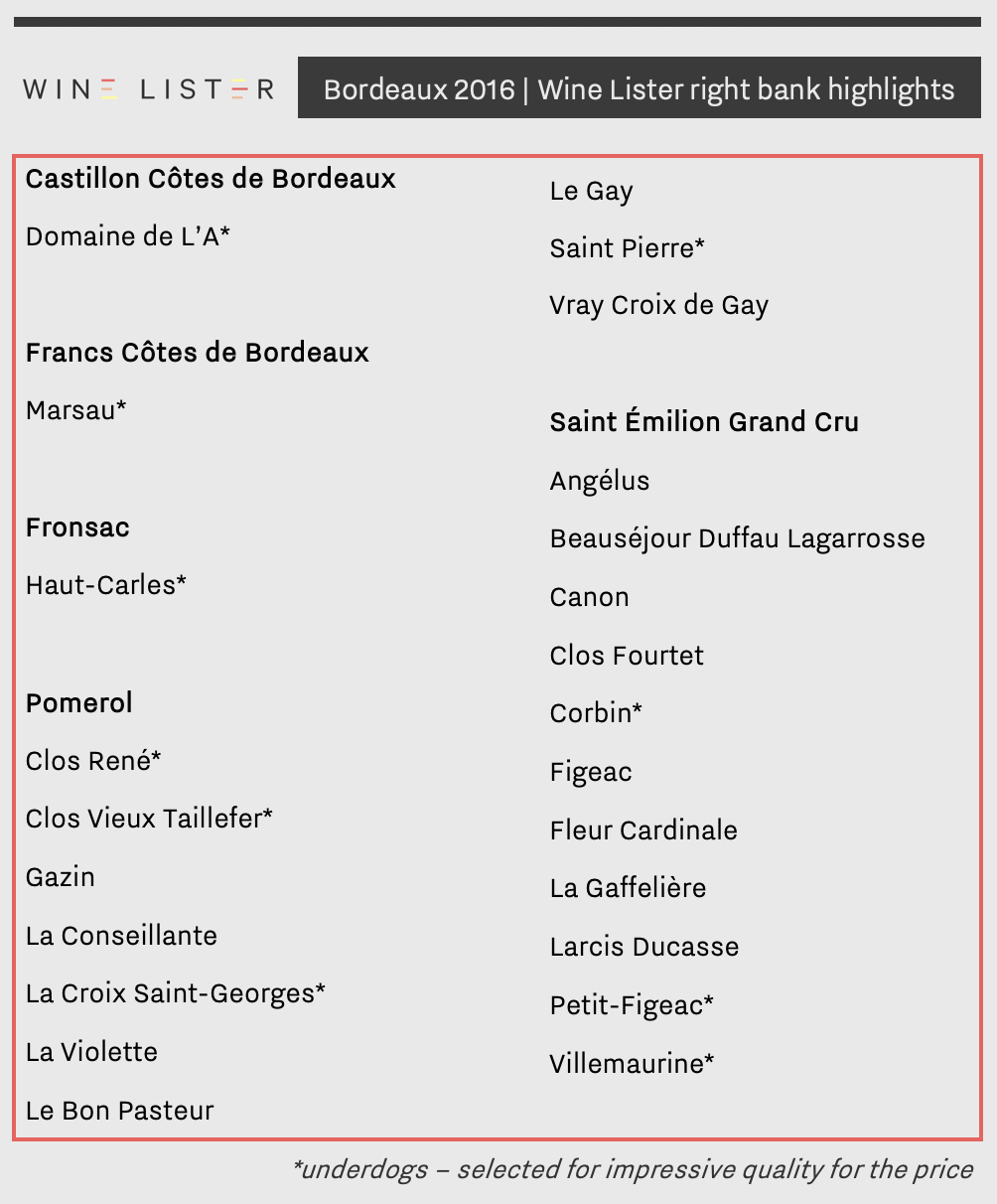 N.B. The tasting did not include wines such as Petrus, Le Pin, Vieux Château Certan, Trotanoy, Ausone, Cheval Blanc, or Pavie.
N.B. The tasting did not include wines such as Petrus, Le Pin, Vieux Château Certan, Trotanoy, Ausone, Cheval Blanc, or Pavie.
However, it was Pomerol that produced more “underdogs” than its neighbour: not-so-big names punching above their weight. Of particular note were Clos Vieux Taillefer and La Croix Saint-Georges.
Among Pomerol top dogs, La Violette was showing beautifully, with a “delicate, fresh” nose and “unctuous, satin” palate. Vray Croix de Gay was “refined” and “thoroughbred”, while La Conseillante produced a “gorgeous, fine-grained texture”.
Further afield, Domaine de l’A from the Côtes de Castillon impressed, as did Marsau, from Francs Côtes de Bordeaux.
Also included in Bordeaux 2016 right bank picks were: Gazin, Saint Pierre, Le Gay, Beauséjour Heritiers Duffau Lagarrosse, Larcis Ducasse, Angélus, Villemaurine, Fleur Cardinale, Clos René, Corbin, and Petit Figeac.
Last week Wine Lister shared top picks from Burgundy 2017 tastings. This week the focus is Bordeaux, after Wine Lister’s founder, Ella Lister, re-tasted through the 2016 vintage with Wine Lister partner critics Michel Bettane and Thierry Desseauve, thanks to négociants Joanne and CVBG.
We are in the process of updating Wine Lister Quality scores based on new, in-bottle scores from Wine Lister partner critics Bettane+Desseauve, Antonio Galloni, and Neal Martin, and in the meantime we share Ella’s left bank picks below.
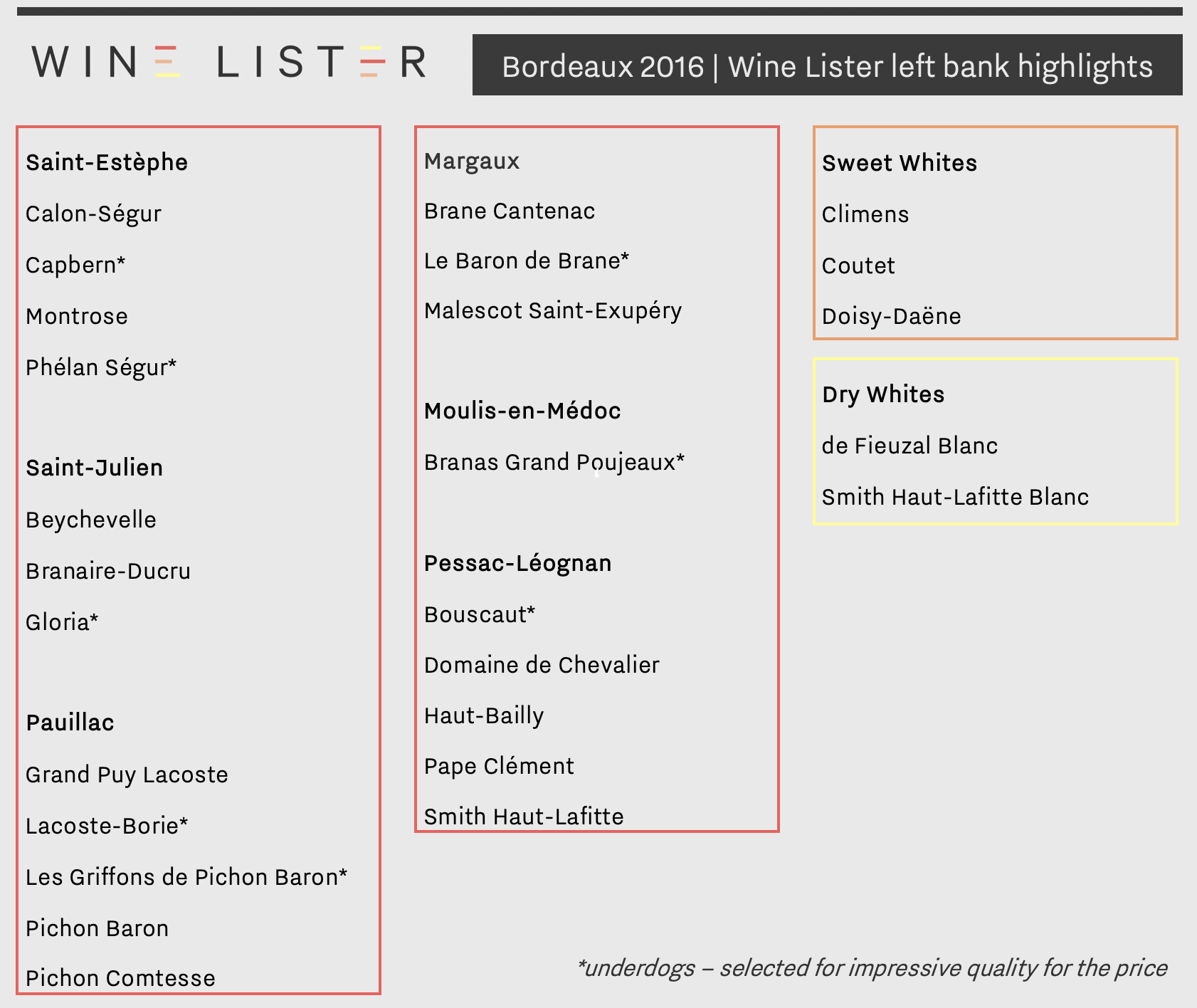 N.B. The tasting did not include first growths, or wines such as Cos d’Estournel, Palmer, Léoville Las Cases, Ducru Beaucaillou, and Pontet-Canet.
N.B. The tasting did not include first growths, or wines such as Cos d’Estournel, Palmer, Léoville Las Cases, Ducru Beaucaillou, and Pontet-Canet.
The spread of favourites from across left bank appellations reflects the homogeneity of the 2016 vintage overall.
Saint-Estèphe was a standout appellation in 2016. Two top dogs, Calon-Ségur and Montrose earned significant praise – Calon is described as having “ballet slipper poise” and a “core of energetic fruit”, where Montrose appeared “elegant, silky and delectable”, with a much-improved integration of oak than the en primeur sample. Beside these sit two underdogs, Capbern and Phélan Ségur, which punch above their expected qualitative weight.
Saint-Julien earns three picks, with Beychevelle being a particular highlight, hailed “ravishing, with vitality and a satin finish”. In Pauillac, Pichon Baron and Pichon Comtesse were both notable, with the former appearing “refined, aristocratic and accomplished”, the latter “exciting, racy, and moreish”. Both Brane-Cantenac and Malescot Saint-Exupéry brought signature Margaux elegance to the tasting mix.
Pessac-Léognan reds were showing particularly well, earning an equal number of highlights as powerhouse Pauillac overall. Haut Bailly made the cut alongside Domaine de Chevalier, Pape Clément and Smith Haut-Lafitte. Bouscaut stood out as the underdog of the Graves.
A few further surprises arose across red appellations, including Gloria, Lacoste-Borie (the second wine of Grand-Puy-Lacoste), and Branas Grand Poujeaux.
Less surprising was the high quality of sweet staples, Climens, Doisy Daëne, and Coutet. Of dry whites, the stand-outs were Smith Haut-Lafitte Blanc (labelled “tonally a step above”), and de Fieuzal Blanc.
Other wines featured in the Bordeaux 2016 left bank highlights are: Branaire-Ducru, Le Baron de Brane, and Les Griffons de Pichon Baron.
A couple of months ago we looked at which Bordeaux 2016s received the best Quality scores, calculated from scores given by our three renowned partner critics: Jancis Robinson, Antonio Galloni, and Bettane+Desseauve. Such quality comes with a price, however, and if the £430 per bottle for Lafleur (Quality score 990) is a little beyond your price range, then we hope this blog is useful. Below are the nine wines from the vintage which qualify as Wine Lister Value Picks.
None of the Value Picks was among the top 15 in our previous blog. Nevertheless, they all enjoy strong or very strong Quality scores on the Wine Lister scale. Fombrauge scores 898, and was described as “rather opulent” and “very successful” by Jancis Robinson. Available at just £16 per bottle, it represents excellent value for money.
Even the wine with the highest Quality score, sweet white Doisy-Daëne (899), is only £25. Those wishing to spend slightly less on a sweet white might also consider Filhot, which achieves a Quality score of 709, and is available at just £14 per bottle.
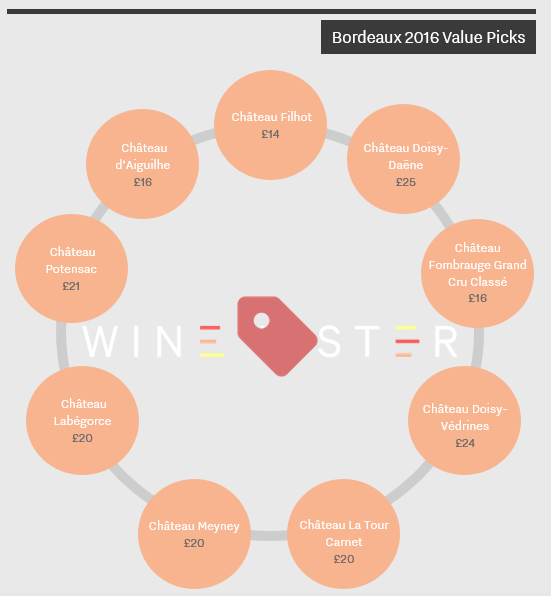
Please see our previous blog for further information on Wine Lister’s Value Picks.
In today’s blog we continue to explore some of the findings from our new in-depth study on Bordeaux, available for subscribers here. Having looked at the wines in which the trade has most confidence, we now turn our attention to Bordeaux 2016, and a key question: how might a château arrive at an appropriate en primeur release price?
Using average figures for 79 of the top Bordeaux crus, we explore two approaches. First, simplistically, we look at release prices of previous vintages, and apply the trade’s suggested decrease of 4% (see here for more) to the average 2015 release price. This is represented by the dotted line.
However, Wine Lister Founding Members were canvassed before having tasted the 2016 vintage, now considered to be excellent, and so the average suggested decrease of 4% on 2015 prices seems unrealistically low. Some châteaux have already released maintaining their 2015 price, which has been well received by the trade, while others have applied increases in euro terms, which in turn are amplified by the current exchange rate when converted into UK offer prices.
For each wine, it is also necessary to take into account the reception by the market of last year’s price, as well as this year’s relative quality.
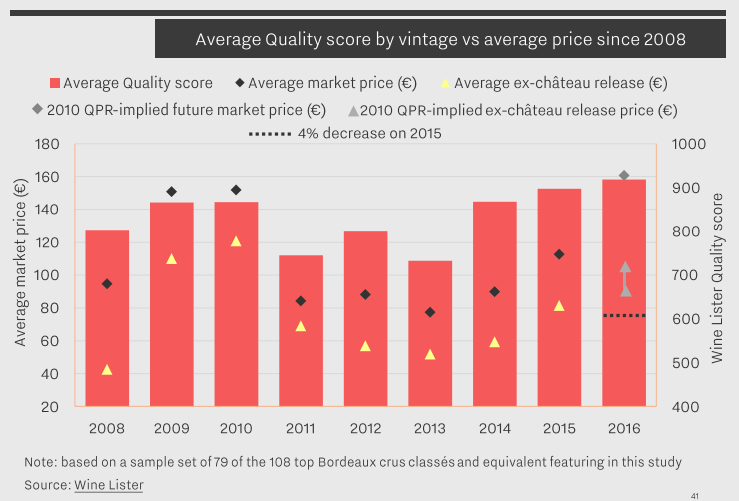
The second, more sophisticated approach, involves comparing the average Quality scores from the last eight vintages to the current market price for those vintages.
The closest quality rating to 2016 is 2015, but as this vintage is not yet delivered, the most appropriate vintage for comparison is 2010. As such, we have applied the quality to price ratio from 2010, in order to arrive at a derived future market price for the 2016 vintage on average, according to its current quality assessment.
The average price per bottle could be expected to reach €161 in the marketplace in due course.
Margins taken by the négociant and then importers tend to amount to around 25-30%, although this varies from wine to wine.
That would take us to around €117 per bottle at release. Then we apply a 10%-20% “discount” to the consumer for buying en primeur, before they receive the physical product. This suggests an average ex-château release price of €93 to €105 (see chart).
In general, this would mean that 2016s should be priced below current market prices for 2015, and well below 2010 market prices.
For further detail, or to enquire about price analysis on specific châteaux, please email team@wine-lister.com.
Now that all our partner critics’ scores have been published, we have been able to feed them into Wine Lister’s bespoke algorithm to arrive at Quality scores for the Bordeaux 2016 vintage. The top 15 wines are shown below.
Wine Lister’s Quality score combines the ratings from our partner critics, three of the most respected critics in the world – Jancis Robinson, Antonio Galloni, and Bettane+Desseauve. A small weighting is also added for a wine’s ageing potential.
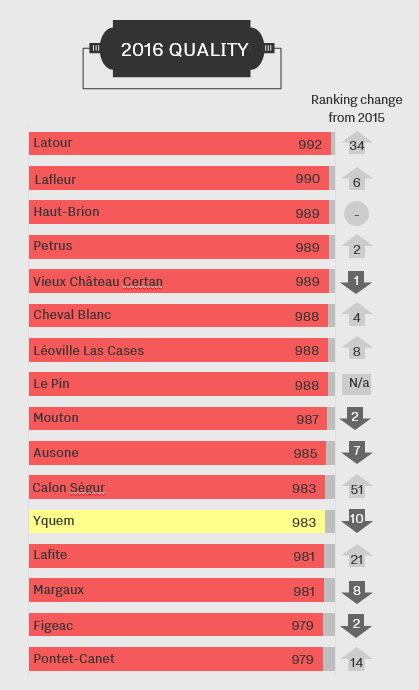
Ironically, the top wine of the vintage is Latour, not available to buy en primeur since the château withdrew from the system in 2012. The Pauillac first growth surged 34 positions up the table from last year, to 992 points for its 2016 Quality score.
Lafleur is just behind on 990, closely followed by Haut-Brion, Petrus and Vieux Château Certan. In fact, all the usual contenders make an appearance in the top 15, including the five first growths, their right bank equivalents such as Le Pin, Cheval Blanc, and Ausone, and Sauternes’ own first growth, Château d’Yquem.
Less obvious showings that are likely to represent better value include Calon Ségur, which improved a mammoth 51 places on last year, as well as Figeac and Pontet-Canet, in joint 15th position.
The top 40 2016 Quality scores will be listed in our upcoming Bordeaux market study, due for release later this week, and available to subscribers here. Alternatively, see the full ranking on the website.
Wine Lister’s French partner critics, Bettane+Desseauve, released their Bordeaux 2016 en primeur scores today. Here is a first look at their top-scoring wines:
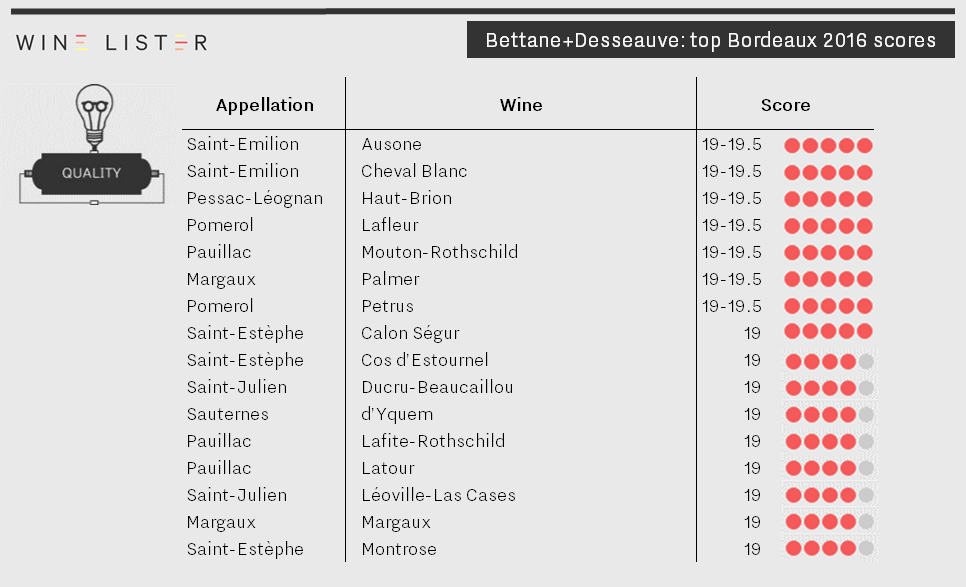
Bettane+Desseauve awarded no potentially-perfect scores, but seven wines score 19-19.5 points. One is Château Ausone, which receives this rave review:
“Refinement of texture and fullness of body. An Ausone of immense depth, broader shouldered than usual but with the same majestic, finessed tannins. A giant.”
As for fellow Saint-Emilion premier grand cru classé A Cheval Blanc, Michel Bettane calls it “the greatest wine from the property, at least as a baby, for at least 20 years!”
All the left bank first growths score 19 or above, as do Petrus and Yquem. Otherwise the top scorers shown above are all first growth equivalents or second growths, apart from Calon-Ségur, a third growth which made a standout wine in 2016.
These scores complete Wine Lister’s partner critic triptych, allowing us to compute Quality scores for the Bordeaux 2016 wines. More detailed analysis will be published next week in this year’s Bordeaux study, which will be available to subscribers here.
Wine Lister’s US partner critic Antonio Galloni, of Vinous, released his scores for Bordeaux 2016 en primeur in a comprehensive article at the end of last week, and these now contribute to Wine Lister’s Quality scores for Bordeaux 2016 wines.
Galloni describes the vintage as one of balance and harmony, yielding “absolutely remarkable wines.” He awarded seven potential 100-pointers, including two first growths – Châteaux Margaux and Latour, as well as three top Pomerol wines – Lafleur, Le Pin, and Vieux Château Certan.
He was particularly impressed by Château Pichon Longueville Comtesse de Lalande, which he found “a deeply emotional, moving wine.” He also had his head turned by Saint-Emilion premier grand cru classé A, Château Pavie, which has shifted towards a more elegant style since 2014, and particularly this year, when Galloni calls it “seamless, sumptuous and super-expressive.”

After waxing lyrical about many of the wines from the 2016 vintage, Galloni turns his attention to the campaign, and to pricing, echoing the positive signs discussed in our recent blog post on this topic. Galloni concludes that given the quality of the vintage, “if the 2016s do not sell well, it will be a damning indictment that one or more things is seriously wrong with how the wines are sold.”
Galloni also appeared on Bloomberg TV to discuss whether 2016 is the Bordeaux vintage of the century. Watch his interview here.
Wine Lister’s UK partner critic Jancis Robinson has released her scores for Bordeaux 2016 over a series of tasting articles, and these can now be found on Wine Lister’s individual wine pages.
While 2016 has been hailed by some as a left bank vintage, Robinson found much to enjoy across both sides of the Gironde. In Pomerol, she praised “those who waited and managed the difficult business of judging picking times correctly”, and more 19-point wines came from this appellation than any other. She singled out Vieux Château Certan 2016 for setting “the standard for the appellation” and noted its “lovely ripeness and nobility.” In Saint-Emilion, 19-point Figeac 2016 was “Zesty and confident and of the place”, while Canon 2016 had “real lift and drive.”
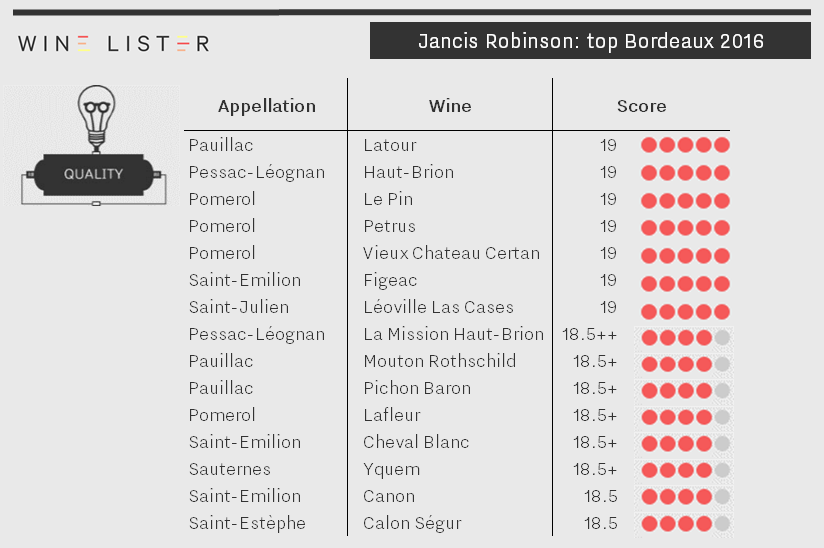
On the left bank, three of the first growths were among Robinson’s top scorers. As Wine Lister has already noted, 2016 was a tricky growing season, and Robinson reports that at Haut-Brion, Jean-Philippe Delmas “pointed out that the vintage was saved by the cool nights that retained the grapes’ and therefore wines’ freshness.”
From Pauillac, Latour 2016 significantly had “much more finesse than traditional Latour”, while Robinson described Mouton Rothschild 2016 as “bone dry and utterly embryonic compared with most of the 2016s (with the notable exception of Las Cases).” Léoville Las Cases 2016 also received 19 points from Robinson.
Notably, amongst Robinson’s top scorers there are no dry whites – a category she described as “the least exciting section of the Bordeaux 2016 vintage” – and only one sweet white (Yquem 2016), a group for which Bordeaux 2016 “won’t go down in history.”
Our recent blog post reported the excellent quality of the Bordeaux 2016 vintage in the face of a tricky growing season, and discussed the generous yields that many producers enjoyed. In theory, the latter should keep en primeur release prices down. We took the temperature during our week in Bordeaux.
Olivier Bernard, President of the Union des Grands Crus de Bordeaux, declared that quantity is “good for the producers and for the people selling our wine, because it will help the château owners find the right price.” He went on to refer to the ease with which “mistakes” are made when quantity is low, a nod to over-zealous en primeur pricing in the past.
In a recent survey of Wine Lister’s 49 Founding Members (key global wine trade players), the average price adjustment for Bordeaux 2016 considered reasonable on 2015 was a decrease of 4%. Even the Bordeaux trade only suggest a 2% increase. It should be noted that this questionnaire was carried out prior to any tastings, and also that the trade’s interest naturally lies in curbing price rises by the producers.
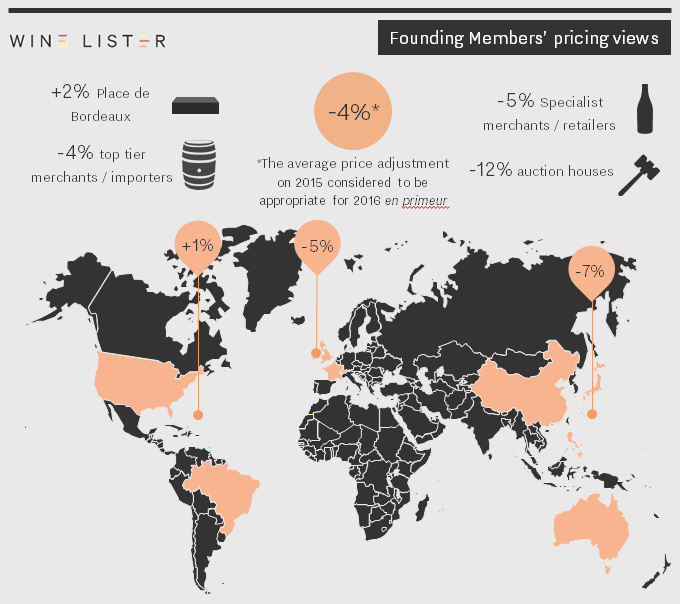
“What’s for sure is that prices to the consumer need to be significantly lower than current prices of physically available vintages such as 2005, 2009 and 2010,” asserted Stephen Browett, Chairman of Farr Vintners. “Why not allow all our distributors and consumers to make good buys and profitable sales of this vintage, with prices that are relatively stable compared to 2015?,” appealed Nicolas Ballarin, courtier at Blanchy et de Lestapis.
Wine Lister’s Founder, Ella Lister, is more sceptical, saying:
“I would be very surprised if Bordeaux 2016 prices do not increase on 2015, in some cases significantly. Every producer we spoke to said they would be upping prices on last year.”
“Price-wise I don’t think there is anyone who’s thinking about selling 2016 at a lower price than 2015,” confirmed Philippe Blanc, Managing Director of Château Beychevelle, hitting the nail on the head when he added, “the big question is how much more.”
This remains to be seen: the mood is broadly bullish but with a dose of caution. François-Xavier Borie, owner of Grand-Puy-Lacoste, summarised, “demand is good, and perception of the vintage is great,” concluding, “we will without doubt raise the price, but it shouldn’t explode.” His only fear is that things might be confused if certain châteaux adopt a different policy, going for “a high price on low volume.” Nicolas Glumineau, Managing Director of Pichon Longueville Comtesse de Lalande, agrees that partial releases at inflated prices are counterproductive, calling the approach “artificial”, and saying it “doesn’t work to sell only 50% at a higher price.” Pichon Comtesse usually sells 80% of production en primeur.
“It’s a great vintage so it will be expensive,” confirmed Glumineau, disclosing, “my ambition is to raise the price this year, yes.” He is acutely aware, as are his fellow Bordelais, of mitigating factors such as the impending French elections. A Marine Le Pen victory “would affect the stock markets”, he says, and “could devalue the euro relative to the pound.”
Referring to the weak pound post-Brexit, Didier Cuvelier, owner of Léoville Poyferré, admitted, “it’s true England worries us as it’s always what sets the tone of the campaign.” Emmanuel Cruse, Co-owner of Château d’Issan and Grand Maître of the Commanderie du Bontemps, Médoc, Graves, Sauternes and Barsac, cited political uncertainty in the UK, the US, and France, when he announced to a room full of producers and négociants, “we all know the situation isn’t stable, but we need to be positive as the vintage is great and we have made a lot of it.” Mathieu Chadronnier, Managing Director of négociant CVBG, observed, “I really feel a desire here in Bordeaux for this to be a successful campaign.”
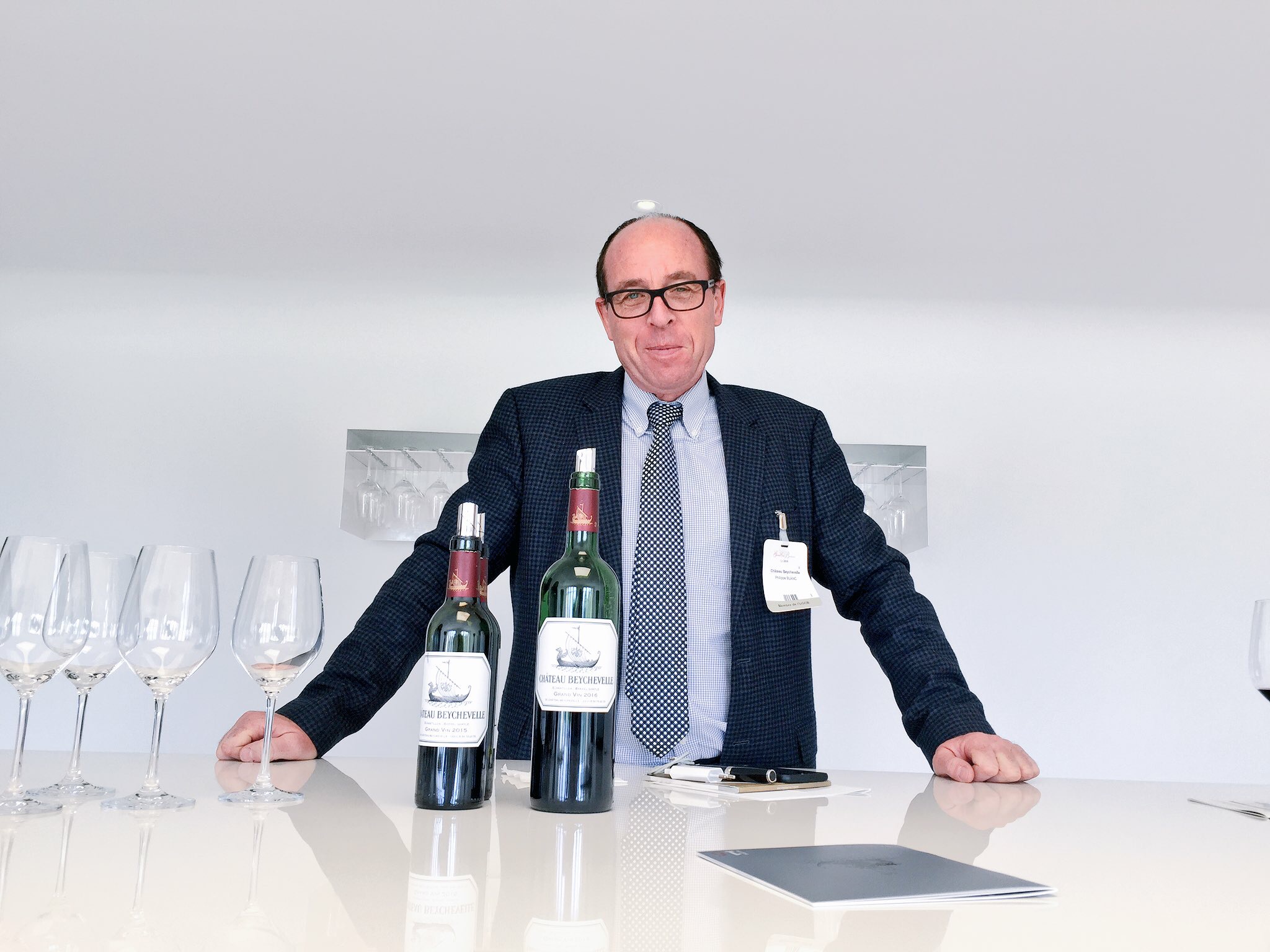
Philippe Blanc, Managing Director of Château Beychevelle, who will almost certainly raise the price on 2015, but won’t be first out of the block. Photo © Ella Lister.
How will this positive approach affect timing for Bordeaux 2016? A couple of sources hinted at the possibility of a handful of early releases at the same price as last year, either by châteaux who priced highly last year or perhaps first growths wanting to set a trend. However, by far the dominant view was that the campaign would be a long one, lasting until after Vinexpo (18th-21st June in Bordeaux).
“A good campaign is one where timing follows a pattern – crus bourgeois first, then the fifth growths, the fourths etc.,” expounds Glumineau. Blanc believes, “the general opinion is not to be quicker than need be,” saying “it’s good to have context,” and confirming that Beychevelle “definitely won’t be the leader timing-wise.” Lister concludes:
“We await the first releases with interest, because of course nobody can predict the campaign’s level of success until the party actually gets started.”
Check www.wine-lister.com in early May for our new Bordeaux study, and follow us on Twitter for real-time analysis of the releases.
The Wine Lister team is back from a week in Bordeaux tasting the 2016 vintage, and we can’t curb our enthusiasm. While the growing season was fraught with difficulty, a series of mini miracles allowed appellations across the board to make their finest wines since 2010. Most crucially, heavy spring rainfall was punctuated by a dry window during flowering, and intense summer drought was broken just in time by a dramatic rainstorm on 13th September, witnessed first-hand by Wine Lister’s Founder, Ella Lister, at Château Smith Haut Lafitte.

A sculpture at Château Smith Haut Lafitte as the storm brewed on 13th September 2016. Photo © Ella Lister
This vintage of extreme conditions has paradoxically resulted in the most balanced of wines, full of freshness. These are wines which, like the 1982 vintage in Bordeaux, will be approachable relatively early – possibly sooner than the 2010s – and will keep on going. Cheval Blanc’s Chef de Culture, Nicolas Corporandy, said that compared to the 2015, “the 2016 is fresher and more tannic”, adding, “they are very different vintages, a bit like the 2009 and 2010.”
However, apart from the odd reference to the 2009-2010 duo, 2016 was not likened to any existing vintage. Olivier Bernard, owner of Domaine de Chevalier and President of the Union des Grands Crus de Bordeaux, declared, “This is another expression – not a 2009 or 2010; we are working at a different level than a few years ago.” Many producers are touting 2016 as their best ever wine, and for once, they might not be exaggerating. “I really think honestly that it’s the most accomplished of all Pontet-Canets,” avowed Alfred Tesseron, owner of Château Pontet-Canet.
We were consistently impressed and delighted by the quality and harmony of the wines on left bank and right. In Lister’s words:
“Saint-Estèphe is driven, Pauillac poised, Pomerol blue-blooded, Saint-Emilion alluring, Saint-Julien classy, Margaux pure, and Pessac-Léognan seductive”.
Many wines exceeded our expectations, and we were especially delighted to return to Smith Haut Lafitte to taste the flawless range of wines and find them entirely unscathed by September’s hail.
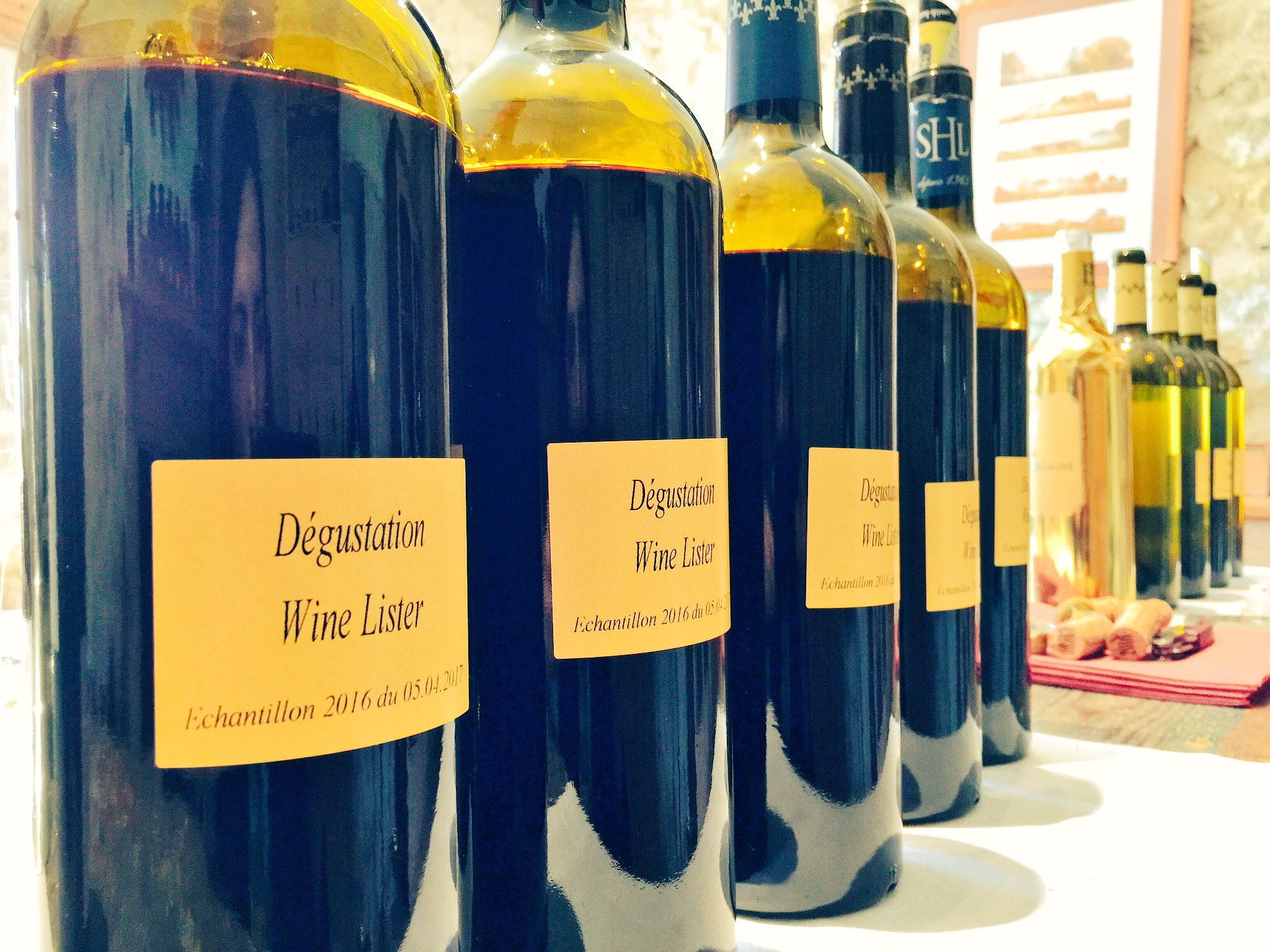
The excellent range of red and white wines tasted by the Wine Lister team at Château Smith Haut Lafitte in Pessac-Léognan. Photo © Wine Lister Limited
The even better news is that in general yields are higher than average (though with several exceptions, such as Châteaux Palmer, l’Evangile, and Léoville Poyferré). “With quality we have quantity and I love quantity,” quipped Bernard.
Why do yields matter? In theory, it should allow the producers to maintain reasonable prices if they have more wine to sell. As Nicolas Audebert, General Manager of Châteaux Canon and Rauzan-Ségla, put it, “Anyone who is intelligent will make their margins on the volume not on the prices; if the prices stay more or less the same when the quality is even better, everyone will be content”.
This could be wishful thinking. In the second instalment of this en primeur round-up we will explore the dynamics of the upcoming campaign, complete with the inside track from top producers and members of the trade regarding timing, pricing, and volumes, coming soon.
Check www.wine-lister.com for our partner critics’ scores over the coming weeks, and a new Bordeaux study, due for release here in early May.
 N.B. The tasting did not include wines such as Petrus, Le Pin, Vieux Château Certan, Trotanoy, Ausone, Cheval Blanc, or Pavie.
N.B. The tasting did not include wines such as Petrus, Le Pin, Vieux Château Certan, Trotanoy, Ausone, Cheval Blanc, or Pavie. N.B. The tasting did not include first growths, or wines such as Cos d’Estournel, Palmer, Léoville Las Cases, Ducru Beaucaillou, and Pontet-Canet.
N.B. The tasting did not include first growths, or wines such as Cos d’Estournel, Palmer, Léoville Las Cases, Ducru Beaucaillou, and Pontet-Canet.








